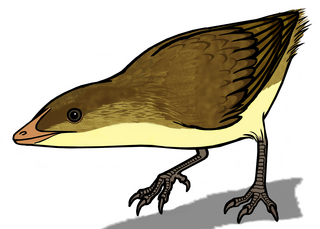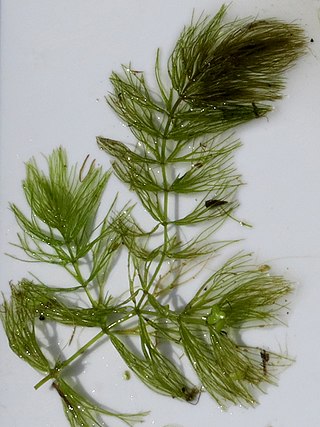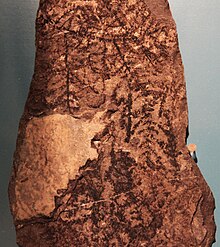
Flowering plants are plants that bear flowers and fruits, and form the clade Angiospermae, commonly called angiosperms. The term "angiosperm" is derived from the Greek words ἀγγεῖον/angeion and σπέρμα/sperma ('seed'), and refers to those plants that produce their seeds enclosed within a fruit. They are by far the most diverse group of land plants with 64 orders, 416 families, approximately 13,000 known genera and 300,000 known species. Angiosperms were formerly called Magnoliophyta.

Ceratophyllaceae is a cosmopolitan family of flowering plants including one living genus commonly found in ponds, marshes, and quiet streams in tropical and in temperate regions. It is the only extant family in the order Ceratophyllales. Species are commonly called coontails or hornworts, although hornwort is also used for unrelated plants of the division Anthocerotophyta.

Indiana University Bloomington is a public research university in Bloomington, Indiana. It is the flagship campus of Indiana University and, with over 40,000 students, its largest campus.

Hydrilla (waterthyme) is a genus of aquatic plant, usually treated as containing just one species, Hydrilla verticillata, though some botanists divide it into several species. It is native to the cool and warm waters of the Old World in Asia, Africa and Australia, with a sparse, scattered distribution; in Australia from Northern Territory, Queensland, and New South Wales.

Neovenator is a genus of carcharodontosaurian theropod dinosaur. It is known from several skeletons found in the Early Cretaceous Wessex Formation on the south coast of the Isle of Wight, southern England. It is one of the best known theropod dinosaurs from the Early Cretaceous of Europe.

Ceratopogonidae is a family of flies commonly known as no-see-ums, or biting midges, generally 1–3 millimetres in length. The family includes more than 5,000 species, distributed worldwide, apart from the Antarctic and the Arctic.

Belidae is a family of weevils, called belids or primitive weevils because they have straight antennae, unlike the "true weevils" or Curculionidae which have geniculate (elbowed) antennae. They are sometimes known as "cycad weevils", but this properly refers to a few species from the genera Parallocorynus and Rhopalotria.

Azorina is a monotypic genus of flowering plants within the family Campanulaceae, whose sole species, Azorina vidalii, the Azores Bellflower, is endemic to the Azores. Its fragmented population is made up of fewer than 1000 mature plants limited to the coastlines of several of the islands. It is also the only species in this family native to the Azores.

Archaefructus is an extinct genus of herbaceous aquatic seed plants with three known species. Fossil material assigned to this genus originates from the Yixian Formation in northeastern China, originally dated as late Jurassic but now thought to be approximately 125 million years old, or early Cretaceous in age. Even with its revised age, Archaefructus has been proposed to be one of the earliest known genera of flowering plants.

Eoalulavis is a monotypic genus of enantiornithean bird that lived during the Barremian, in the Lower Cretaceous around 125 million years ago. The only known species is Eoalulavis hoyasi.

Ceratophyllum demersum, commonly known as hornwort, rigid hornwort, coontail, or coon's tail, is a species of Ceratophyllum. It is a submerged, free-floating aquatic plant, with a cosmopolitan distribution, native to all continents except Antarctica. It is a harmful introduced weed in New Zealand. It is also a popular aquarium plant.

Pipimorpha is an unranked clade containing all frogs which are more closely related to living Pipidae species than to living Rhinophrynus species. Members of this group are highly adapted to aquatic life. The oldest pipimorphs are Neusibatrachus and Gracilibatrachus from the Early Cretaceous of Spain, with other records of the group known from Afro-Arabia and South America like modern Pipidae. The extinct family Palaeobatrachidae, particularly the genus Palaeobatrachus were widespread and abundant in Europe during the Cenozoic, until their extinction during the Middle Pleistocene around 500,000 years ago due to being unable to cope with the increasing aridity and freezing temperatures of the ice ages.

Ceratophyllum echinatum, known as prickly hornwort, spiny hornwort, or spiny coontail, is an aquatic, perennial plant found in North America. Its name comes from fruits, which have a warty surface and long spines. Spiny hornwort can be found in ponds and lakes, principally in eastern North America. It is the only species of its genus endemic to North America.

Koumpiodontosuchus is an extinct genus of neosuchian crocodyliform that lived in the Early Cretaceous. The only species is K. aprosdokiti, named in 2015.

Archaeornithura is an extinct genus of ornithuromorphs from the early Cretaceous period. It is known from two fossil specimens of a single species, Archaeornithura meemannae. The specimens have been dated to the Hauterivian age, 130.7 million years ago, making A. meemannae the oldest known ornithuromorph, the lineage that gave rise to modern birds, and contains all living birds as well as many of their extinct relatives.

Padillasaurus is an extinct genus of titanosauriform sauropod known from the Early Cretaceous Paja Formation in Colombia. It contains a single species, Padillasaurus leivaensis, known only from a single partial axial skeleton. Initially described as a brachiosaurid, it was considered to be the first South American brachiosaurid ever discovered and named. Before its discovery, the only known brachiosaurid material on the continent was very fragmentary and from the Jurassic period. However, a more recent study finds it to be a basal somphospondylan.
Spinolestes is an extinct mammal genus from the Early Cretaceous of Spain. A gobiconodontid eutriconodont, it is notable for the remarkable degree of preservation, offering profound insights to the biology of non-therian mammals.

Soriatitan is a genus of brachiosaurid sauropod from the Early Cretaceous of Spain. It is known from one species, S. golmayensis, found in the Golmayo Formation. It lived between 138 and 130 million years ago was identified by a team of paleontologists in Spain.

Vallibonavenatrix is a genus of spinosaurid dinosaur from the Early Cretaceous (Barremian) Arcillas de Morella Formation of Castellón, Spain. The type and only species is Vallibonavenatrix cani, known from a partial skeleton.
Ploufolia is an extinct genus of plants in the order Nymphaeales. It existed in northeastern Spain during the Upper Albian period. One specimen of a species named Ploufolia cerciforme was discovered in 2010 at the Utrillas Formation, near Plou, Teruel Province; the genus name is derived from the locality of Plou.


















